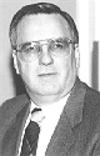James P. Noblitt
For outstanding engineering and executive leadership in his work on the B-52, in the Apollo program, and on the space station, the Schools of Engineering are proud to present the Distinguished Engineering Alumnus Award to James P. Noblitt.
Vice President and General Manager, Missiles and Space Division,
Boeing Defense and Space Group
BSAE 1957

On life as a Purdue student
Purdue was a much bigger pond than I'd been used to. I'd gone to a small high school in Rockville, Indiana, and it took a while to adapt. My fellow students had a strong influence on me; a number were Korean War vets who were older and more mature than I was. They had come back to college knowing what they wanted and determined to get it. They set a very, very brisk pace. In striving to keep up, I had to do a lot of growing up.
I do remember one summer school session. In the 1950s the School of Aeronautics required students to attend a summer semester, which focused on practical, hands-on experience with hardware.
The class I remember best involved disassembling and reassembling an aircraft engine. I got an old German jet engine, one of the first pure jets built in Germany during World War II.
Two things stick in my mind: One is how extremely hot it got that summer in one of the old hangars out at the Purdue airport. The other is having a couple of bolts left over when I finally got the engine back together. I left them inside the engine. I've always wondered whether the next student to disassemble that engine found them and was able to put them back where they belonged. On the other hand, maybe some practical joker just tossed them in my parts pile.
On the space age
One of the things that was happening while I was at Purdue was the dawning of the space age. The rocketry advances made in Germany during WWII had provided a means of reaching earth orbit. And although Sputnik wasn't launched until October 1957, just after I graduated, rocketry and space flight were being actively discussed during my college years. I remember sitting on the front porch of my home in Rockville in about 1955 or 1956, talking with a neighbor lady about placing an object into orbit. She simply didn't believe that such a thing was possible. It was an incredibly different world than today. I'd gone to Purdue expecting to spend most of my career designing and building airplanes, but it wasn't long after graduating that I moved into rocketry and later into space systems.
On his career's accomplishments and challenges
I've been fortunate to work on projects that have been on the forefront of aeronautics and space. I'm especially proud that many of these were pioneering efforts, including the Minuteman [the first intercontinental ballistic missile] and Saturn V/Apollo. I worked on Wernher Von Braun's team in Huntsville, Alabama, designing and building the rocket that carried the astronauts to the moon. At Boeing I managed the space-station proposal team in the late 1980s and am now in charge of Boeing's prime contractor team.
The greatest challenge to the aerospace industry is the restructuring brought on by the end of the Cold War. Mergers and acquisitions are revolutionizing the shape of the industry. And that process is far from over.
The internationalization of the business is another challenge. On the space station, for example, we have the participation of the U.S., Canada, Europe, Japan, and Russia. It's the largest multinational scientific project ever undertaken-and learning to work with an old adversary, Russia, is a novel and challenging activity.
On the significance of a Purdue education
One thing I really think Purdue got right in educating engineers is the practical, hands-on training we received. That summer when I tore apart and rebuilt the engine is one example. Another one, which I'll never forget, is running the survey course around the campus and struggling to get closure. More important than the surveying skill I learned-which I never used again-was the lesson in the absolute importance of discipline and precision in doing successful engineering. It's something that has stuck with me throughout my career.
The most important thing Purdue can do is to continue to produce high-quality engineers. That is the primary function of the Schools of Engineering and the yardstick by which Purdue engineering will be measured. Instilling in students a solid grounding in engineering fundamentals, a recognition of the need for continual learning, and an ability to think independently is essential.
- 1993:
- Vice President and General Manager, Missiles and Space Division, Boeing. Responsible for Boeing's work as prime contractor on NASA's international space station program and on the Air Force/NASA inertial upper-stage booster rocket program; for R&D programs for the Department of Defense's Ballistic Missile Defense Organization; and for developmental efforts on various civil and military space systems.
- 1992-1993:
- Vice President and Assistant Manager, Missiles and Space Division.
- 1989-1992:
- Vice President, Space Systems. Had product-line responsibility for space transportation, space defense, and space and advanced projects.
- 1986-1989:
- Manager, Experimental Development Programs. Led multifunctional team in development and production of advanced systems. Managed successful bid to develop manned elements of space station Freedom.
- 1984-1986:
- Chief Engineer, Experimental Development Programs.
- 1974-1984:
- Principal contributor to the Air Force ASAT (antisatellite) concept. Responsible for overall technical direction of launch segment development, system integration, and flight testing.
- 1967-1974:
- Managed preliminary design activities for advanced air-launched missiles.
- 1964:
- Assigned to Saturn V integration program.
- 1960-1964:
- System Engineer, Boeing. Worked on B-47 and B-52 bombers and Minuteman program.
BSAE 1957, Purdue.
